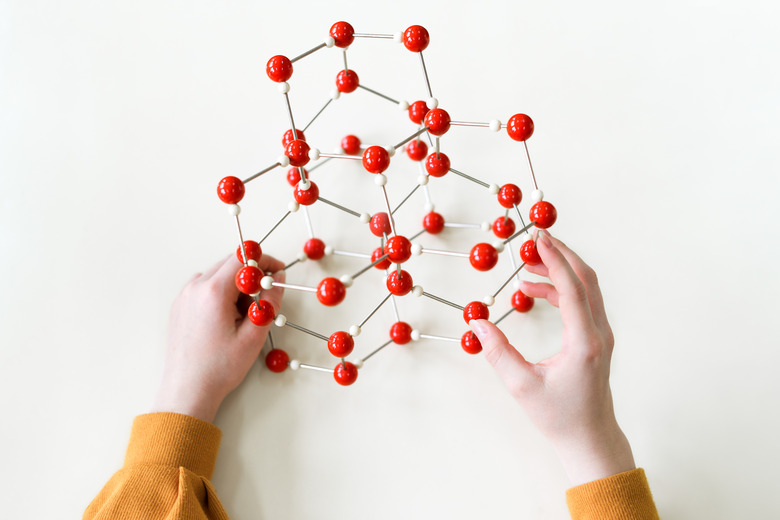Similarities & Differences Between Ionic & Covalent
Everything around you is held together by chemical bonds. From the molecules that make up your body and the salt you put on your food to the chair you're sitting on, covalent and ionic bonds hold matter together in the forms we interact with on a day-to-day basis. Learning about ionic and covalent bonds is an important part of any introductory chemistry course, and finding out the differences between bonds gives you an insight into why different materials behave and react in distinct ways. The topic is simple, but it opens the door to a much deeper understanding of the world around you.
Ionic Bonds and Covalent Bonds Defined
Ionic Bonds and Covalent Bonds Defined
The basic definitions of ionic and covalent bonding help you understand why they're so different. An ionic bond is one formed between two ions with opposing charges. An ion is an atom that has lost or gained an electron so it is no longer electrically neutral. The loss of an electron means the ion has more protons than electrons and has a net positive charge. Gaining an electron means there are more electrons than protons. This ion has a negative charge.
Covalent bonds work differently. The valency of an element tells you how many "spaces" there are in the outer shell of electrons for bonding with other elements. In covalent bonding, molecules are formed by the constituent atoms sharing electrons so they both have full valence (outer) shells, but some electrons occupy the outer shells of both elements at the same time.
Similarities Between Ionic and Covalent Bonds
Similarities Between Ionic and Covalent Bonds
The differences between bonds are clearly important because ionic and covalent compounds work so differently, but there are a surprising number of similarities. The most obvious similarity is that the result is the same: Both ionic and covalent bonding lead to the creation of stable molecules.
The reactions that create ionic and covalent bonds are exothermic because elements bond together to lower their potential energy. By nature, this process releases energy in the form of heat.
Although the specifics differ, the valence electrons are involved in both bonding processes. For ionic bonding, valence electrons are gained or lost to form a charged ion, and in covalent bonding, the valence electrons are shared directly.
The resulting molecules created through both ionic and covalent bonding are electrically neutral. In covalent bonding, this is because two electrically neutral components come together, but in ionic bonding, it's because the two charges join and cancel each other out.
Both ionic and covalent bonds form in fixed quantities. For ionic bonds, fixed amounts of ions join together to form an electrically neutral whole with the amounts depending on the excess charges on the specific ions involved. In covalent bonding, they bond according to the number of electrons they need to share to fill their valence shells.
Differences Between Ionic and Covalent Bonds
Differences Between Ionic and Covalent Bonds
The differences between bonds are easier to spot, but they're just as important if you're trying to understand chemical bonding. The most obvious difference is the way the bonds are formed. However, there are several other differences that are just as important.
The individual components of a covalently bonded molecule are electrically neutral, whereas in ionic bonding they are both charged. This has important consequences when they're dissolved in a solvent. An ionic compound like sodium chloride (table salt) conducts electricity when dissolved because the components are charged, but individual molecules formed by covalent bonding don't conduct electricity unless they're ionized through another reaction.
Another consequence of the different bonding styles is the ease with which the resulting materials break apart and melt. Covalent bonding holds atoms together in molecules, but the molecules themselves are only weakly bonded to one another. As a result, covalently bonded molecules form structures that are easier to melt. For example, water is covalently bonded and ice melts at a low temperature. However, an ionic material like salt has a lower melting point because its whole structure is composed of strong ionic bonds.
There are many other differences between bonds. The molecules that make up living things are covalently bonded, for example, and covalent bonds are more common in nature than ionic bonds overall. Due to the difference in bonding styles, covalent bonds can form between atoms of the same element (such as hydrogen gas, which has the formula H2), but ionic bonds can't.
Cite This Article
MLA
Johnson, Lee. "Similarities & Differences Between Ionic & Covalent" sciencing.com, https://www.sciencing.com/similarities-differences-between-ionic-covalent-8158237/. 26 April 2018.
APA
Johnson, Lee. (2018, April 26). Similarities & Differences Between Ionic & Covalent. sciencing.com. Retrieved from https://www.sciencing.com/similarities-differences-between-ionic-covalent-8158237/
Chicago
Johnson, Lee. Similarities & Differences Between Ionic & Covalent last modified March 24, 2022. https://www.sciencing.com/similarities-differences-between-ionic-covalent-8158237/
